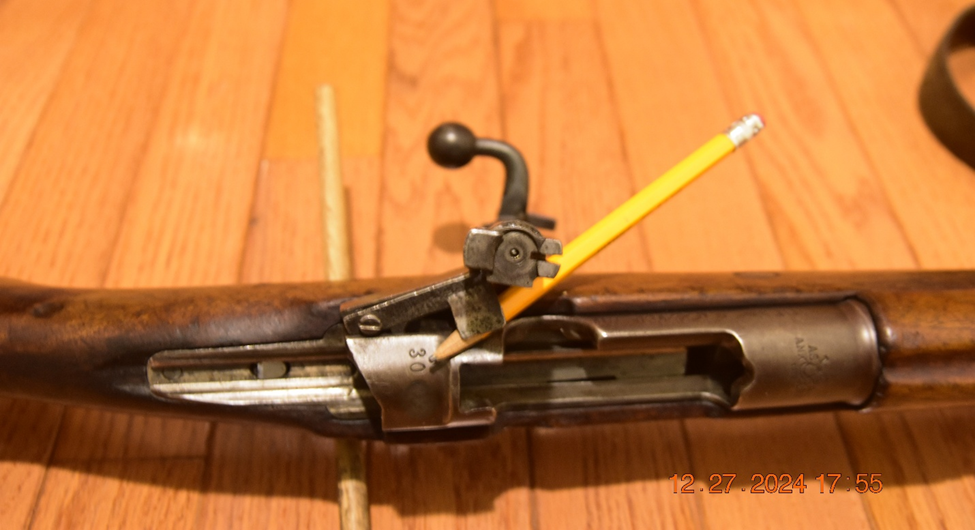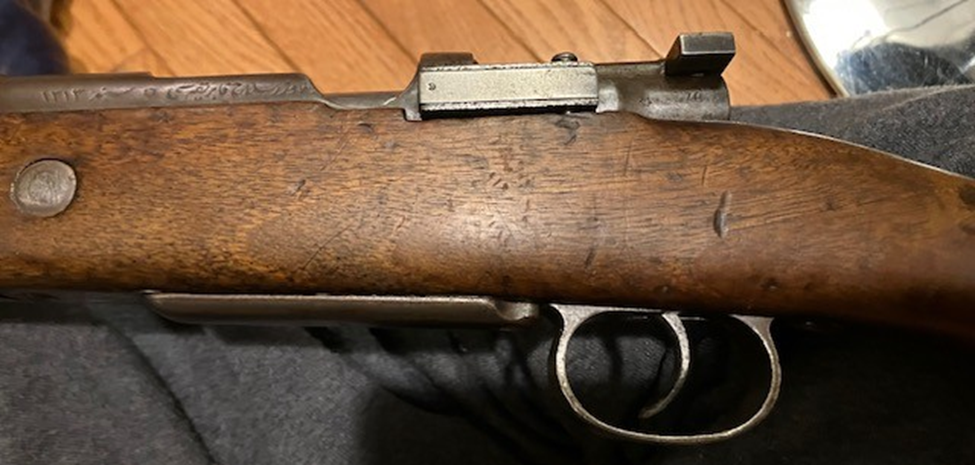The specimen shown above is a variant of the 1893 model made
by the Mauser Company for Turkiye, a major customer during that era. The Turkish
Mauser 93 contract consisted of 201,100 rifles entirely manufactured by
Mauser’s factories and not subcontracted to others. In 1938 these rifles were
standardized to be more consistent with the specifications of the later Mauser
1903 pattern (itself a later version of the Gewehr 98). The following
modifications were introduced to accommodate the change in cartridge caliber
from the original 7.65x53 to 8x57 mm:
1.
Grinding of the back end, front end, and left
rear of the loading port on the 1893 receiver to accommodate the longer 8x57 mm
cartridge, and to model it after the 1903 pattern.
2.
Grinding off the old seal of Caliph Abdülhamid 2
and remarking as TC ASFA ANKARA. The abbreviation TC stands for Turkiye
Cumhuriyeti (Republic of Turkiye) whereas ASFA is Askari Fabrika (military
factory). The marking straddles the crescent moon and star emblem of Turkiye. The
year of conversion was also stamped beneath the marking.
3.
On most conversions the magazine cut-off of the
1893 receiver was also removed. Please consult reference 1-3 to review the
original configuration of the Turkish Mauser 1893.
4.
Obviously, re-barreling was necessary but I could
not find any documentation about the process. It was either a fresh new 8x57 mm
barrel or reboring the old one.
5.
Both rear and front sights were modified to
accommodate the new ballistics.
6.
And finally, restocking to the 1903 pattern with
a more pronounced hand grip, recoil lug supporting the receiver, and metal discs
on both sides of the butt for firing pin disassembly.
Close-up of receiver with bolt removed: view of enlarged
loading port, new arsenal markings with year of modification (1938) stamped
beneath, original magazine cut-off eliminated, handguard retaining ring also
eliminated. The specimen shown also features a magazine follower that had been ground
down at the back to allow for free bolt movement without inserted cartridge (no
bolt stop). I am not sure if it was part of the original arsenal modification. The
serial number on the rear of the receiver was electronically masked.
Left side view of receiver with bolt inserted: the back of the left side was ground down to model after the 1903 pattern. The Arabic markings on the left read: 1313H (or 1895 in the Gregorian calendar, the year of manufacture) followed by Arabic markings for Arms Manufacture Mauser. The marking for Oberndorf was obliterated by metals being ground off. The recoil lug on the left side of the stock is also clearly visible.
Bolt retracted from action: note that unlike the regular bolt stop on Spanish Mauser 1893, the Turkish variant curls up and wraps around the rear receiver bridge as in some older Mauser’s.
Bolt taken out: Note the classic square bottom of the model 1893 Mauser bolt. This rifle has its bolt handle bent down and with the first three digits of the receiver serial number stamped on it.
The trigger group and lightly domed magazine floor plate typical of 1893 Mauser’s survived the modifications. Note the crescent moon stamp and Arabic numbering (tentatively read as 296).
Buttstock view: As for the Gewehr 98 and 1903 patterns
the modified stock features the pronounced hand grip and metal disks on both
sides to facilitate firing pin disassembly.
Buttstock plate
modified to 1903 pattern with no discernible markings.
The 1893 type rear sight was replaced with the 1903 type. The range markings on the elevation leaf were in Western numerals extending from one hundred meters to 2000 meters. The bottom of the elevation leaf near the V notch was marked with the receiver serial number but erased electronically in this picture. The slider left side was also stamped with the last three digits of the receiver serial number but likewise erased in this picture.
Handguard retaining band is typical of 1903 pattern
with side retaining pin in sharp contrast with the original 1893 pattern
where the pin is located underneath. The sling shown here is not proper Turkish
Mauser, it was a loaner from an 1896 Swedish Mauser.
Muzzle end: the front retaining band is again 1903 pattern, shown here with the correct cleaning rod. The front sight protector is not proper Turkish, but a loaner made for Swedish Mauser’s 1896.
Muzzle end with bayonet attached: the bayonet and
corresponding scabbard are of the correct short Turkish M38 type.
The bayonet hilt was clearly stamped with arsenal
marking (AS. FA for Askari Fabrika) and serial number (partially masked
electronically).
Muzzle front view:
the bore is dark, but the lands are still strong.
In summary, this specimen is still in great shape (easily
NRA VG). I have shot more than eighty rounds of modern 8x57 through it
achieving reasonable accuracy at both 100 and 300 yds range, considering the
age of the bore.
Additional reading at: Ottoman Turk Mauser: Model
1893/38
References
1.
Ottoman Turk Mauser: 1893
2.
Mauser Bolt Rifles by Ludwig Olson, 3rd
Edition, Updated 7th Printing, 1976, F Brownell & Sons
Publishers, Montezuma, Iowa, 50171. Pages 75-77.
3.
Mauser Military Rifles of the World by Robert
W.D. Ball, 3rd Edition, 2003, Krause Publications, Iola, WI 54990.
Page 320.

















No comments:
Post a Comment